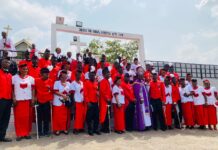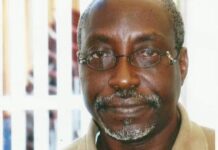The Lagos/Ibadan expressway, Nigeria’s first multi-lane express route, has over the years, become a paradox in the hands of successive Nigerian governments. Paradox, in the sense that many of the narratives associated with this expressway are weird, inconsistent with what obtains elsewhere and symbolize a wisdom which only Nigerian runners of government have access to.
A 127.6-kilometre-long (79.3 mi) expressway which connects Ibadan, the capital of Oyo State and Lagos, Nigeria’s largest city and major artery into the northern, southern and eastern parts of Nigeria, it is the oldest expressway in Nigeria.
Awarded to Julius Berger Nigeria and Reynolds Construction Company Limited at an initial cost of 167 billion Nigerian Naira or $838,986,290, the construction was divided into two sections for the two companies to handle. While Berger handles 43.6 km stretch of the road, to wit the Lagos to Shagamu portion, RCC is saddled with the rest, which is Sagamu to Ibadan. Commissioned in August, 1978 by then Major General Olusegun Obasanjo, the expressway has conveniently morphed into a bottomless pit for consumption of cash, a potential cesspit of political corruption if a klieg is peered into it and a wisdom gourd which only runners of Nigeria have access to.
This wisdom gourd reminds me of a famous Yoruba folktale. By the way, in folkloric tales of Yorubaland which seem to have died the moment modernity meandered into the world, Tortoise and Snail play very central roles and representations. While Tortoise represents trickery, craftiness and greed, Snail represents smartness, alertness and native wisdom. On occasions where Tortoise and Snail spar in exhibition of wisdom, while Tortoise meets its waterloo, Snail excels. In their denotations, Yoruba preach the wisdom of the Snail and abhor the Tortoise signifier. Indeed, in one of their proverbs, they say that no matter how Tortoise thinks he is clever, he is outshone by the Snail, rendered as gbigbon ti ahun gbon, ehin l’o nto’gbin.
As is usual with the Siamese nature of riddles and folklores, riddles are always appetizers for the central folklore stories. Thus, this particular storyteller begins by asking, “Who can tell me the two tiny birds which effortlessly climb two hundred trees simultaneously?” When one of the children listeners, apparently the most brilliant one among them, replies that it is the eyes, then the storytelling begins.
Here it goes: Upon waking up one certain morning, centuries ago, Tortoise was consumed with the bother about how he could outwit the rest of the world. He then agreed with himself that he needed to acquire the whole of the wisdom existing in the whole world, so that no living being would be as wise as he was. To achieve this, Tortoise then began the process of acquisition of global knowledge. He walked all over the place to seek it. Holding a clay pot in his hands, his plan was that, whenever he found a shell of wisdom, he would drop it inside the clay pot. By the end of the week, Tortoise had succeeded in acquiring the total wisdom of the world. He was excited and celebrated this immensely. Then, wary of someone else appropriating this knowledge from him, he thought of where to warehouse the huge corpus of wisdom, away from access to other human beings.
Then, the tallest palm tree in the village came to his mind. With the clay pot tied to his chest, off he began to climb the tree. As he was about getting to the mouth of the tree, his legs slipped and the pot came crashing down. Totally downcast, he repeated the process thrice, with same result. As he did the third time, a villager watched him and counseled that his backside, rather than his chest, was where to tie the clay pot containing global wisdom. Persuaded to climb the tree again, Tortoise was almost at the top of the tree when he angrily threw the pot away. The moral intended by the framers of this folklore is that wisdom is communal and social which should not be restricted to personal usage.
No one can contest the fact that the Lagos/Ibadan expressway boasts of the hugest traffic in Nigeria. As the busiest inter-state route in the country with over 250,000 Passenger Car Unit (PCU) the largest of such in Africa, its construction was with an eye on it withstanding heavy volume of vehicle traffic, especially vehicles with high axle loads. Contract for its reconstruction was begun by former President Goodluck Jonathan in July, 2013 and the aim of its reconstruction was to shrink the time of travel for millions of commuters who travel on it daily. Since then, the road has witnessed several stasis and hiccups. Again, the Federal Executive Council approved an additional N80bn for the purpose of rehabilitating Section II of the Expressway which fell on the Sagamu to Ibadan axis. On several occasions, work had stalled embarrassingly on a number of occasions on the construction due largely to funding discrepancies.
Funding of the project initially became an issue. Concessioned to Bi-Courtney of Wale Babalakin, it was eventually terminated in a messy separation. The concession was initially for 25 years, for construction and maintenance of 105-kilometre expressway. A private finance initiative, it was expected that this would see the reconstruction through, providing 70% of the funds needed, with the Federal Government providing the rehabilitation of 30% of the cost. In 2016, the Infrastructure Bank Plc and Motorways Asset Limited was said to have secured the sum of N170 billion funding for the reconstruction of the expressway, through public-private partnership. This caused uproar in the parliament as its desirability became a subject of discussion.
In 2017, the year of its initial scheduled completion, before its postponement, while President Muhammadu Buhari was on medical vacation to the UK, his government, represented by Vice President Yemi Osinbajo, requested a virement of the sum of N135.6bn into what it called “other pressing sub-heads” in the 2017 budget. Lawmakers subsequently reduced allocation to the road construction from N31billion to N10billion. This necessitated the two contractors suspending work on the road, even as they cited mounting unpaid debts to them by the Federal Government.
As it is now, the Federal Government seems to appropriate and approximate all the wisdom of the world in one single pouch in the funding of the road construction. Earlier, it had announced that a #321million it recovered from late former Head of State, Gen. Sani Abacha, would be spent on the same project. Recently, it again announced that it was going to deploy the £4.2m loot recovered from James Ibori, former governor of Delta state, to fund three infrastructural projects, the Lagos–Ibadan, Abuja–Kano expressway and the second Niger bridge. The loot was seized from Ibori in 2012 after his conviction for fraud and money laundering by a UK court.
Many have argued that government should return the loot to the purse from where it was initially filched. The House of Representatives also recently directed government to stop its plan to spend the Ibori loot on the road, kicking against FG keeping the money. Dilemma in argument arose when such line of argument was reminded that Delta had, during the pendency of Ibori’s trial, claimed that no money was stolen from its purse.
Rather than manifesting, exhibiting and walking on the road of this Tortoise-wisdom-of-the-world, FG should let Nigerians know how much has been expended thus far, since 2013, on the Lagos/Ibadan expressway and how much is still needed. This nebulous voting of looted funds into the road construction, which leaves the actual figures spent shrouded in mystery and the fact that the true spending so far on the expressway exists solely in the mind of government, bears acute resemblance to Tortoise’s wily attempt to make the wisdom of the world resident solely in his head.






